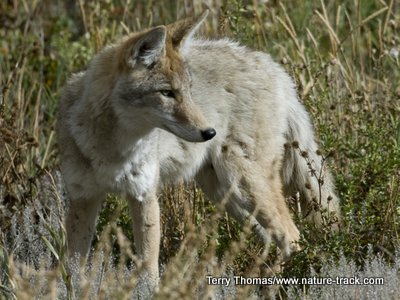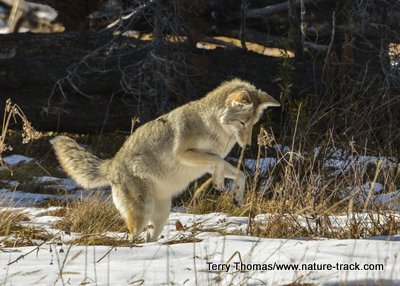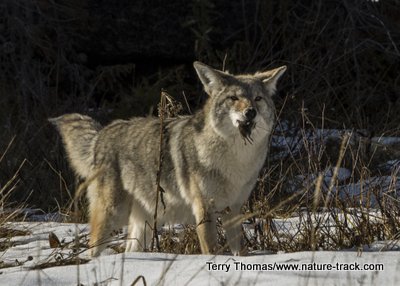Living with Coyotes

With its beautiful winter coat, yellow eyes and perky ears, the coyote is a handsome animal. However, it is a WILD animal, not a pet dog. Don't be deceived, the coyote doesn't look at YOU as a friend, but rather a source of food.
To say that the coyote is adaptable is to say that a supermodel is sort of good looking. This canine is one of very few native species that have actually dramatically expanded their range since the European settlement of this continent.
Historically, the coyote was restricted to an area of the central United States and Mexico. Over two hundred years, it has expanded north to Alaska, south to South America, throughout the entire east coast including Canadian provinces and to the Pacific. In fact, until you start to approach the Arctic Circle, there is not a place on the North American continent, including Central America, where you can’t find coyotes.
Not only has the coyote expanded its range, it has learned how to live in close proximity to humans. It is not uncommon, for instance, to see coyotes crossing city streets and freeways in Los Angeles County, California. The same can be said for New York City, Chicago and most other cities across the nation.
More amazingly, this expansion occurred during a time when a virtual war had been declared against the coyote and the federal government had the intention of causing their extinction. Millions of coyotes succumbed to poisons, traps, bounties, aerial gunning and more from the late 1940’s through the early 1970’s, but their numbers just increased. And they learned how to live with their most dangerous neighbor, man.
Sightings of coyotes in urban areas is becoming increasingly common. Scientists who study coyotes put the number of urban coyotes somewhere between one and ten million. Los Angeles alone is thought to be home to over 5,000. Even the low end is a lot of coyotes. So, is it possible that even here in Eastern Idaho, coyotes can be city neighbors? Given that most of our neighborhoods are bounded by native habitat and farm/rangeland, it would actually be surprising if we didn’t have coyotes denning in our parks, strolling the greenbelt and walking neighborhood streets in search of the stray pet or two. The question is, is it a danger and if so, what can we do about it?
First, I want to point out that coyotes do have a purpose. In a study conducted in Cook County, Illinois (that is where Chicago is), researchers found that a typical urban coyote diet consisted of 42% rodents. With thousands of coyotes roaming the area, that is some pretty economical and ecological rodent control. So, coyotes aren’t bad, in fact they are useful.
However, the increased contact with humans has led to some tragedies as well. Taylor Mitchell, a vivacious 19-year-old musician from Canada, was the first documented fatality of an adult human by coyotes. She was attacked in a national park in Nova Scotia and died from her injuries in 2009.
The number of reports of non-fatal coyote attacks has been steadily increasing. Los Angeles County Animal Control reports that they usually receive a dozen calls a day regarding coyotes getting into mischief or behaving badly.
Most often, young children are the targets of attacks and that is worrisome. Although dog bites and attacks are far more common than coyote bites or attacks, there is one major difference in my mind. Excepting feral dogs, dog attacks are seldom attempts at predation. That may not be the case with coyotes who are predators from head to toe. There is one documented fatality of a young child, Kelly Keen, a three-year-old California girl who died from injuries sustained in a coyote attack in 1981. However, there are dozens of accounts of coyotes attacking people, especially young children, and many of the attacks center on the neck or face just as a coyote might attack a deer. Kelly Keen’s neck was broken in the attack.
So, here in the Wild West, our first thought might be, “Kill them all”. Many communities have experimented with lethal control only to find what the federal government discovered. Unless you can successfully kill over 70% of the breeding pairs—almost never accomplished—all lethal control will do is stimulate production. Younger coyotes breed, litter sizes increase and territories shrink (allowing more territories), all of which cause the exact opposite of the desired result.

If we hope to live peaceably with these new canine neighbors, they need to maintain the justifiable fear of humans that they have developed over thousands of years. However, it is humans that need to change, not the coyotes.
Here are some suggestions to help you get along with coyotes (seen or unseen) in your neighborhood.
1. Don’t feed them. This is the number one way that coyotes lose their healthy respect for humans. The coyote that killed little Kelly Keen was being fed by neighbors.
a. Feeding includes, of course, giving them handouts, but it also means pet food, bird food and trash. Feed pets indoors, keep birdfeeder areas clean and keep lids tightly on trash cans. Adding a little ammonia to your trash receptacle makes it less attractive as well.
b. Fruit was the second highest dietary component in the Cook County study, at 22%. This means that fruit that falls from your trees can readily attract a hungry coyote. Keeping fruit picked up will reduce that temptation.
2. Keep pets close. While the Cook County study didn’t find pets to be a big part of a coyote’s diet, there are numerous incidents of coyotes attacking cats and dogs in other areas, even German Shepperd-sized dogs. One favorite tactic is for a single coyote to entice a dog to chase it. It then leads it to the pack which easily overwhelms the dog.
a. If you are in a coyote prone area, you should remember that even fences often don’t keep a cunning coyote out. The buried electric fence that works in conjunction with a shock collar may keep your dog in the yard, but it is clearly no barrier to a coyote.
3. Make your yard less coyote friendly.
a. Close off crawl spaces under porches and sheds and remove other potential denning areas such as piles of lumber or old farm equipment. Coyotes use such areas for resting and raising young. This is good advice for a number of wildlife species you don’t want under your house such as skunks and raccoons.
b. Install outdoor lighting and trim bushes. Don’t give coyotes a place to hide.
4. Don’t try to approach or pet a coyote. Geez, I really hated to include this one as it should be a “no-brainer”. Coyotes aren’t dogs, they are predators. They aren’t friendly and their first reaction to being touched is likely to be a bite. You don’t need that and neither does the coyote, as it is likely to get him or her killed for being a safety risk. Any time you encounter a coyote in your neighborhood you should actively try to scare it off. This will help to maintain that healthy respect coyotes simply must have for humans.
5. If you raise animals like rabbits and chickens, make sure the cages are secure. Rabbit hutches should have a solid bottom and use a substantial wire mesh, not chicken wire, for the sides. For a chicken coop, bury the wire mesh at least a foot underground. Coyotes are good diggers and a chicken coop is an irresistible temptation until they find it impregnable.
6. If faced with an aggressive coyote, do not run. That will almost certainly induce a predator response. Instead, stand your ground and pick up small children and pets. Throw things, yell, do whatever you can to intimidate it. Really big coyotes are less than 50 pounds, but they make their living by killing so you need to act very tough.
7. Educate your children. Emphasize to them that coyotes are not friendly neighborhood dogs. Don’t let young children go outside without close supervision. Kelly Keen was in her driveway when she encountered the coyote that killed her.
Coyotes are awesome animals. Their intelligence and adaptability are unparalleled in much of the animal kingdom. Watching one hunt for mice is a stellar wildlife experience. Just remember that they are predators with the capability of inflicting serious injury. Keep your distance and always make sure that the coyote respects and fears you by following the recommendations above. We can then be good neighbors.

A coyote in Yellowstone National Park prepares to pounce on a small rodent.

Success! Small rodents make up the majority of a coyote's diet and humans benefit from their efforts to keep rodents in check. Coyotes do not need food subsidies from humans. All feeding them will do is create a coyote with no respect for humans.

"WOW. What a phenomenal piece you wrote. You are amazing." Jennifer Jackson
That is embarrassing, but actually a fairly typical response to my nature essays. Since The Best of Nature is created from the very best of 16 years of these nature essays published weekly in the Idaho Falls Post Register (online readership 70,000), it is a fine read. It covers a wide variety of topics including humorous glimpses of nature, philosophy, natural history, and conservation. Readers praise the style, breadth of subject matter and my ability to communicate complex and emotional topics in a relaxed and understandable manner.
Everyone can find something to love in this book. From teenagers to octogenarians, from the coffee shop to the school room, these nature essays are widely read and enjoyed.
Some of the essays here are my personal favorites, others seemed to strike a chord with readers. Most have an important message or lesson that will resonate with you. They are written with a goal to simultaneously entertain and educate about the wonderful workings of nature. Some will make you laugh out loud and others will bring a tear to the eye and warm your heart.
Readers Write:
"You hit a home run with your article on, Big Questions in Nature. It should be required reading for everyone who has lost touch with nature...great job!" Joe Chapman
"We enjoyed your column, Bloom Where Planted. Some of the best writing yet. The Post Register is fortunate to have your weekly columns." Lou Griffin.
To read more and to order a copy, click here or get the Kindle version
Copies are also available at:
Post Register
Island Park Builders Supply (upstairs)
Barnes and Noble in Idaho Falls
Harriman State Park, Island Park
Museum of Idaho
Valley Books, Jackson Wyoming
Avocet Corner Bookstore, Bear River National Wildlife Refuge, Brigham City, Utah
Craters of the Moon National Monument Bookstore, Arco, Idaho